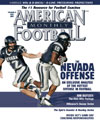AMERICAN FOOTBALL MONTHLY THE #1 RESOURCE FOR FOOTBALL COACHES
Article CategoriesAFM Magazine
|
AFM Subscribers Ask...with Ron Vanderlinden© More from this issue Ron Vanderlinden, now approaching his seventh year as Linebackers Coach at Penn State, has developed a reputation as an outstanding linebackers mentor. Over the years, he has coached Penn State All-Americans Paul Posluszy and Dan Connor, Pat Fitzgerald and Barry Gardner of Northwestern and Chad Brown of Colorado. He also helped the Nittany Lions defense rank in the top 15 nationally in rushing, pass efficiency, scoring, total defense and sacks in 2005. Similarly, his Northwestern defense in 1995 led the nation in scoring defense. He answers your questions on defense and, more specifically, linebacker play… Q. What is the first thing you and your defensive staff look for on film after you have established the basic offensive philosophy of your opponent? Justin Dixson, assistant coach, Warren Central High School (IN).....The full article can only be seen by subscribers. Subscribe today!
|
|
|||||||
| HOME |
MAGAZINE |
SUBSCRIBE | ONLINE COLUMNISTS | COACHING VIDEOS |
Copyright 2025, AmericanFootballMonthly.com
All Rights Reserved





